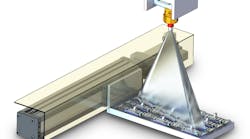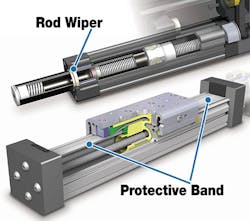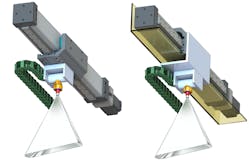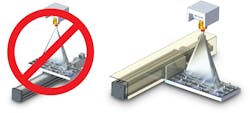The IP (Ingress Protection or International Protection) code rating is an internationally recognized system developed to standardize the degree of protection that “enclosures” provide against foreign objects, water, or materials entering into these enclosures, causing damage or personal injury. IP codes also apply to linear actuators.
Practically speaking, the higher the numeric IP rating against dry solids and moisture, the higher the level of protection offered. But how do these code ratings apply to rod-type and rodless linear actuators, and which ratings are appropriate for which applications?
Dusty Environments
It’s easy to find linear actuators in dusty manufacturing environments. Fortunately, dust generated from paper or corrugated materials (cardboard), textiles, and normal factory activity tends to be dry and relatively lightweight. Most rod-type linear actuators can perform in this type of environment without adverse effects. But adding rod wipers improves the odds that dust won’t make it to the internal components and help retain lubrication inside the actuator. Rodless actuators also perform well in this relatively benign environment, as many include a cover strip that shields internal components from dust that gets inside.
If dust is more prevalent, rodless actuators may be further protected by adding a positive pressure port on the actuator body. This equalizes internal and external pressures and helps keep dust away from possible ingress points. In such factory environments, IP54 would be the minimum rating to consider as it would be protected from dust (5) and splashing water (4), even though splashing water may not be present.
In extremely dusty conditions where materials are being cut (such as in woodworking), or where there is light metal machining and grinding, dust accumulation tends to be considerably heavier. In these applications, a higher rating such as IP65 should be considered. It means the device is “dust-tight” (6) and protected from low-pressure (4.4 psi) jets of water. Even though water may not be present, the sealing mechanisms for keeping actuators dust-tight are typically effective against low-pressure water. Rod-type actuators with rod wipers or rod seals also perform well in these conditions. However, rodless actuators typically do not perform well unless some kind of custom-designed protection is applied. Custom-designed protection is best provided by the machinery manufacturer.
Liquid Environments
In applications with water present, it is important to fully understand the source, direction, and volume of the water the actuator will experience. For example, with an actuator carrying a reciprocating spray head directed away from the actuator and toward the processed product, some of the water, mist, or vapor will inevitably settle back on the actuator. It should therefore be protected against splashing water or low-pressure jets. The sealing mechanism of most rod-type actuators consists of a rod wiper or rod seal, so actuators with a rating of IP65 would be satisfactory. Rodless actuators will let some water in at some point unless custom-designed shields or guards are installed.
Some actuators, such as those that move products within the range of sprayed water, will be directly in the path of water. These devices should carry an IP66 or IP67 rating. Devices with these higher IP ratings will typically have redundant exclusion mechanisms such as shields, bellows, or guards, ensuring long-term operation. Again, rodless actuators will not perform well in these applications without customized protection.
Washdowns
Actuators are commonly found in food- and beverage-handling equipment that requires frequent washdowns. In such cases, actuator protection requirements are particularly stringent because the equipment is often cleaned with aggressive detergents, as well as washed and rinsed with hot (180°F), high-pressure (1,500 psi) water spray or steam. When specifying actuators for such applications, it’s important to understand the chemical makeup of the cleaning solutions. For example, the effects of very high or very low pH solutions on various components need to be fully understood so that sealing materials used are compatible with the detergents and pressures and do not degrade. This also requires that the metals used in the construction of the actuator body resist the particular cleaning solutions. Actuators with a rating of IP69K are best suited for this environment. However, it is always wise to perform testing on the solutions used in the process to ensure chemical compatibility.
Applications involving chemical solutions need to be treated somewhat differently than applications involving simple water ingress. IP ratings do not imply chemical compatibility. Knowing exactly what chemicals actuators will be exposed to helps the actuator supplier select materials most likely to offer good service life. Important factors to consider are the chemical makeup of the solution being used, its concentration level, duration of exposure to components to which it is applied, and operating temperatures.
Linear rod-type and rodless actuators are used in a wide variety of manufacturing applications that employ motion control in adverse environments that expose them to dust, liquids, and a variety of chemical solutions. Generally speaking, rod-type actuators are better suited to these types of conditions. Rodless devices can also be employed at ratings of IP54 or less. For higher levels of ingress protection, rodless actuators typically require some kind of external shields or enclosures.
When selecting linear actuators for applications that require protection against dust and liquid ingress, engineers should provide their supplier with as much information as possible about the dust and liquids the actuators will be exposed to so the supplier can ensure environmental compatibility, best performance, and long service life.
Gary Rosengren is the Director of Engineering at Tolomatic Inc.
Decoding the IP Rating |
|
An IP rating consists of the two letters “IP” for ingress protection, followed by two numbers and possibly a letter. The first number (0 through 6) indicates how effective the device or component is protected against ingress by solids. The second number (0 through 8) indicates the protection level against liquids. The first number, protection against solids, breaks down as follows: 0: No protection 1: Protected against object larger than 50 mm. (This included any large part of the body, such as the back of the hand, but no protection against deliberate contact with the body) 2: Protected against anything larger than 12.5 mm (fingers or similar objects). 3: Protected against objects larger than 2.5 mm (Tools, thick wires, etc.) 4: Protected against objects larger than 1 mm (most wires, screws, etc.) 5: Protected against dust. Dust might get in, but it won’t affect the operation of the device. 6: Dust tight. Dust cannot get in. The second number, protection against liquids, are defined as: 1: No protection 2: Protected against dripping water. 3: Protected against dripping water when the device is tilted at up to 15°. 4: Protected against spraying water. 5: Protected against splashing water. 6: Protected against water jets (water from a 6.3-mm nozzle). 7: Protected against powerful water jets (water from a 12.5-mm nozzle). 8: Protected against immersion in water up to one meter deep. 9: Protected against immersion in water more than one meter deep. There originally was a third number that indicated how well the device was protected against mechanical impacts. It is no longer used. There’s also a unique IP rating, IP69K, which is part of the German DIN 40050-9 standard. The “K” indicates the device is protected against high-pressure, high-temperature washdowns. |



